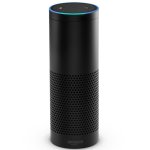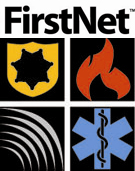
Amazon’s Echo
I recently attended and spoke at the Government Technology Beyond-the-Beltway event. Our panel of local and state Chief Information Officers (CIOs) was asked “what is the most significant technology advance in your lifetime”. I answered “either the IBM PC or the iPhone”. Others mentioned the Internet and the world-wide-web. (No one mentioned the development of email, invented by Ray Tomlinson, who just recently passed away, and sometimes considered the bane of our existence.)
A more significant question might be “what will be the most significant technology advance in the near future”. Or, to narrow it a bit, what will be the most significant technology advance for public safety first responders in the near future?
I’m convinced such technologies already exist, or, in the words of William Gibson: “the future is here, it is just not evenly distributed yet”.
One of the candidates is Amazon’s Echo.
Echo is a speech-enabled technology which is arguably better than Apple’s Siri or Microsoft’s Cortana and which can be used right now in homes to do everything from order more laundry detergent to play music to control the thermostat. All by recognizing speech. And connecting to Amazon’s website, of course.
We hire and extensively train police officers, state troopers, sheriff’s deputies, firefighters and paramedics as first responders. Then, because we want to be “data driven”, we tell them to sit down at computers and type crime reports, hand-write medical reports, prepare fire code inspections and do what are essentially clerical tasks which take them away from the real work of law enforcement and fire protection.
Enter Echo.
Why don’t we have Echo-like devices in police vehicles and fire apparatus and even in police officer badges or firefighter helmets?

Comm Badge
Can you imagine a cop who comes to your house to investigate a burglary, taps her badge (just like the CommBadge in Star Trek) and asks “Alexa, have any red Schwinn bicycles been recovered lately?” or “Alexa, search all nearby pawn shops for Canon EOS rebel single-lens reflex cameras sold in the last three days”.
Or the traffic officer who goes to his police car and simply speaks to the car “Car 54 take a collision report for two vehicles who collided at this intersection twenty-two minutes ago,” then proceeds to dictate the report to the car. And the Echo-like device in the car prompts the officer for any additional information, even doing database searches returning information like “Officer Schrier, I detect that the red Ford Mustang involved in this collision has fourteen unpaid parking tickets. Shall I call for a tow truck?”
Similarly paramedics responding to an emergency medical call could talk to their devices “Alexa, get me the detailed health records for William M. Schrier, apparent heart attack victim, specifically including any known medications he is using and any known adverse reactions to meds”. Or “Call Schrier’s personal physician at the highest priority, locating the doctor immediately for this emergency.” And that same paramedic could dictate observations and reports, rather than hand-writing them or typing them.

Language Translation
Another significant use for speech-activated devices are language translation. We are a nation of immigrants, and real-time translation services like Google translate or Skype.
Although most police cars are equipped with mobile data computers today, many police officers are justifiably skeptical of writing reports in their vehicles, especially if it means looking down at a screen and a keyboard, and not paying attention to their surroundings. Killing of police officers like those in New York City, Houston/Harris County, and Lakewood (Washington) have reinforced this fear. But with speech-to-text such as Echo, officers might be able to spend more time on the street, less time at computers in the police station.
Even in daily situations, police officers who need to tap or type on their in-car computer while driving represent a potential hazard to themselves and others. Being able to give verbal commands such as “acknowledge that dispatch and set status to en route” or “text Sergeant Schrier that I’ll be following up immediately” improve not only speed but also safety for officers.
Echo and similar technologies do, however, require high speed Internet access.
For first responders working in the field, that means 4G LTE networks. The First Responder Network Authority (“FirstNet”) is planning to build just such a network, specifically designed for first responders. FirstNet will, perhaps, have applications, apps and devices specifically tailored for first responder missions. FirstNet recognized the importance of such voice technologies in a blog post here.
Even more importantly, public safety software vendors of computer-aided dispatch systems (CAD) and fire/police records management systems (RMS) should immediately start integrating speech-to-text technologies into their products. A speech-enabled RMS will significantly reduce the time for a paramedic, law enforcement officer or firefighter to create reports. Such reports will be more accurate and of higher quality, and first responders will spend more time on the streets and less time typing in front of a computer.
Echo or similar speech-to-command technologies should be high on FirstNet’s list. And on the list of any company creating software for first responders.




Pingback: Jessica Santos
Dear Mr. Schrier:
From a cost standpoint (forgetting that funding for FirstNet has already been secured), why don’t we Just use a BeOn app (or one of the other alternatives) on a BYOD smartphone? You get PTT (plus some MCPTT on LMRs) and high speed broadband for the most part.
Karthik
BeOn and EsChat are good apps and are used by many responders. However these apps are “over the top” meaning they are just apps that run on the network like, say, email or maps. We need push-to-talk apps that are integral to the network itself, actually interacting with the network’s cell sites and central management (that is the LTE core) to manage their priority.
Imagining a future where technology improves the success of first responders and saves more lives is the first step to making it real. I can imagine the potential as you describe it! It would be great to have your perspective as one of the voices at the inaugural event of the Digital Business Hub (www.digital-northwest.com). Let me know if you are interested and I can get you more info. Erika
Pingback: Why I’m Joining FirstNet | the Chief Seattle Geek blog